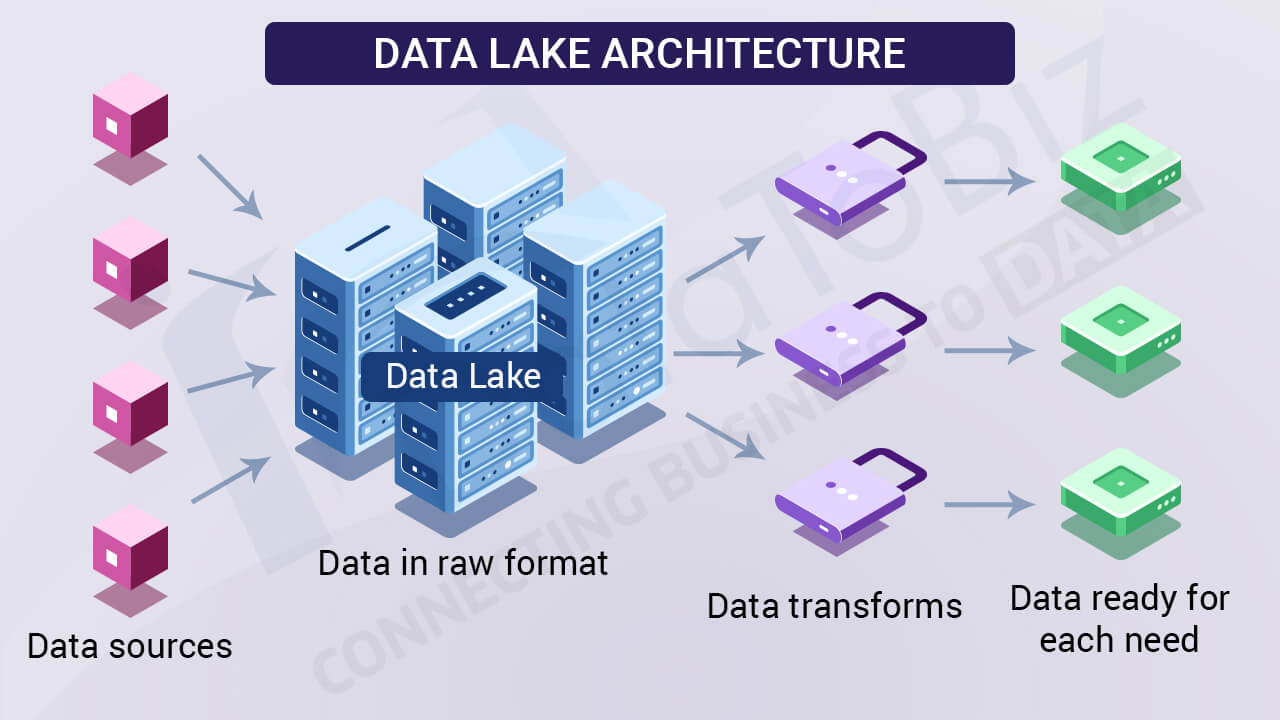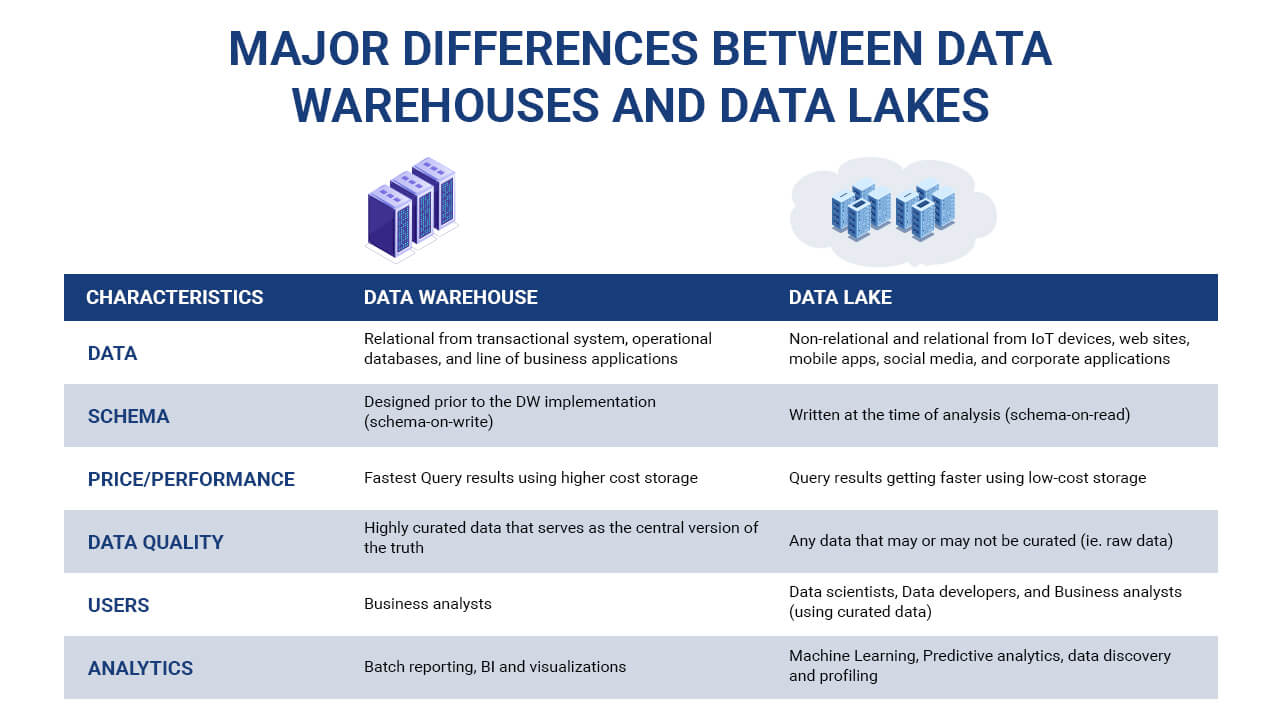Data is a salient factor for every business. While it has always been a necessity, nothing in the past compares to the need for big data we see today. No matter if it is a startup or a multinational enterprise, data from the past and present are collected, processed, analyzed, and presented to help make better decisions.
Business intelligence and data analytics are an imperative part of many enterprises now. But where does all this data go? It sure needs to be stored somewhere secure, private, and easy to access, right?
Many of you might have heard of the terms data lake and data warehouse. These are data storage architectures that allow you to store a huge amount of data in one place. While their main purpose is the same, the two have nothing much in common.
Do you know that 95% of businesses face a problem due to unstructured data?
However, several SMEs and organizations tend to get confused between a data lake vs data warehouse. And without knowing what they are, there’s no way an enterprise can choose the right one for their requirements.
A data warehouse is a depository that stores data in one place before it is analyzed and presented using various BI tools. It is one of the first things you need to work on when revamping the business processes.
All business intelligence applications require a data warehouse to deliver meaningful insights. The data warehouse combines components and technologies where raw data is structured and processed to derive information.
A data warehouse is more of a traditional data storage system tried and tested by many businesses. Does that mean it’s the best, or does it mean it’s an older version and not as useful?
It’s neither. The data warehouse has its advantages and disadvantages.
The role of data warehouse in business intelligence is a lot more intricate than you would expect. Whether you want to retrieve data in less time or find a crucial piece of information without searching all over the enterprise, a data warehouse offers a quick and effective solution.
The data warehouse can be integrated with numerous other systems so that it becomes easy to translate data and present it in an understandable format. If you want to know more about your customers, all you need to do is connect the data warehouse to your CRM system.
DWs usually have schema-on-write, SQL servers understand how the system works. That makes it simpler for the data warehouse to deliver good performance whenever its need arises.
DWs ensure that the data stored in them is not incorrect. It shows the errors that need to be fixed, the duplicates that have to be removed, etc., before proceeding to the next step. However, there is a difference between data warehousing and business intelligence.
A data warehouse is not a business intelligence tool. DW deals with data acquisition, data cleansing, management, metadata, data transformation, backup, and more.
The data warehouse has been here long enough to easily find resources and tools to use with it. While it can be a little challenging to work with the latest functionalities, DW is a reliable and proven storage option for enterprises.
Third-party consulting companies offer Data warehousing services to help you build, manage, and upgrade the data warehouse in your enterprise. The advantage of DW is that it can be housed on-premises or can be stored and accessed from the cloud platforms.
That said, DW has its share of disadvantages that makes enterprises consider data lakes. Let’s check the cons of data warehousing before reading about data lakes.
Even though DWs are used to simplify the business processes, it might take a little more time to manually feed raw data to the data warehouse. That is something many enterprises are wary of.
The confidential nature of data might result in restricted access to the data warehouse. And that can directly translate to limited use of data. Data warehousing might be a little less effective if only certain employees can access data.
Data warehouse delivers its best when it’s upgraded to the latest version. While the process isn’t hard, the cost can be slightly on the higher end. Unless you can invest money to maintain and upgrade the DW, it won’t be as effective.
A data lake is a relatively new concept that has gained a lot of attention in recent times. A data lake is different from traditional storage systems as it stores data in its raw format.
Of course, it can also hold structured and semi-structured data, including binary data. It is pretty much a single storage location for raw data and transformed data.
The data lake architecture is flat, where every element has a label and a corresponding metadata tag for easy identification. The data collected from numerous sources are added in real-time to the DL in its original format. No changes are made to the data at this stage.

Data lakes make it an easy job of handling big data, whether it is structured or unstructured. A data lake is schema-on-read, and this lets us read the format only when we read it back out.
DLs are easy to update. You don’t require to spend too much time transferring data to the data lakes. It all happens in real-time.
Any user group can easily find the data they want by looking at the open data copies. Of course, you can control and restrict access to certain groups, but it’s still easy to get hold of what one wants without compromising data security.
While data lake is not cheap, it is a cost-effective option when compared to data warehouses. That allows us to store any kind of data in it without worrying about the costs.
DLs can be scaled horizontally to make the most of what they can offer.
Data lakes support the Internet of Things (IoT) and advanced algorithms. They can be integrated with various tools to trace patterns and recognize objects using algorithms.
Before going into the disadvantages, let’s understand that a data reservoir is not a data lake but an enhanced and upgraded version of a data lake built exclusively to overcome the disadvantages of data lakes.
Though DLs can be built on-premises, they are more effective on cloud platforms. Enterprises that do not use cloud services might have to migrate the entire setup to the cloud to use data lakes.
You will have to plan for the transition period when moving things from the original setup to the data lakes. There could be some ripples in the enterprise.
Your employees need to have the required skills and knowledge to work on data lakes as it uses advanced technology. You will either have to give training to them or hire outside services.
Unlike the data warehouse, data lakes don’t have a query engine that makes it easy to find what you want.
The first difference is in the data warehouse and data lake architecture.
DWs are complex models and can have multiple layers. A Data warehouse can be a single-tier, two-tier, or three-tier, where each tier deals with a different aspect.
The bottom tier is a rational database system.
The middle tier is an OLAP server and acts as a medium between the database and the end-user.
The top tier is the frontend tier connected with APIs and other tools to collect data from the DWs.
The data lakes have a flat architecture and still contain lower and upper levels. Data moves across the levels with minimum or no latency.
The lower levels have data at rest, while the upper levels have real-time transactional data.
Data warehouses contain cleaned and transformed data that is extracted from transactional data. It is ready to be used as it is to derive insights and generate reports.
Data lakes contain all kinds of raw and unstructured data irrespective of its source. This data is transformed only when it needs to be processed.
The biggest complaint about DWs is that making any sort of change can be a herculean task.
In data lakes, the data is kept in its raw form, which isn’t of much use until it is transformed.
In a data warehouse, the majority of the time is spent analyzing the data sources, processing data, eliminating errors, and formatting it.
Here, we need to read a little about data lake vs. data warehouse vs. data mart.
Data warehouses capture structured and formatted data arranged in a specific order (or schema) as decided by the enterprise to work in data analytics.
Data lake captures structured, unstructured, and semi-structured data in their original forms straight from the sources.
The data warehouse has been in use for a long time, unlike big data, which is a more recent development.
Data lakes are used by big data technologies are a relatively new concept that is fast gaining popularity due to their advanced features.
Here is where the data warehouse takes a back seat. DWs are costlier to maintain, and they need regular upgrades to integrate them with the latest features and technology.
Data lakes, though not cheap, are comparatively cost-effective and come with a better-designed architecture.
The task of a data warehouse is to provide insights into pre-defined data types. Even the questions are predefined and can offer limited insights that are used to generate reports.
The task of a data lake is to allow users to access raw and unstructured data before it has been processed and transformed.
Data warehouses are designed for operational users because it is structured to suit their requirements.
Data lakes are for analysts and advanced analytical techniques such as predictive analysis and statistical analysis.
Since the data warehouse is structured, any changes that need to be made will take more time.
Data lakes make it easy to get results when compared to DWs.
DWs use the Extract Transformation Load (ETL) process.
DLs use the Extract Load Transform (ELT) process.
In a data warehouse, a schema is defined before the work starts, and the data is stored.
In data lakes, the schema is defined after the data is stored. This results in agility and makes data capturing easier.

Data warehouse consulting services are used for operational aspects such as identifying performance metrics and generating meaningful reports.
Data lakes can be used for in-depth analysis that allows analysts to ask new questions and identify new patterns.

To declare one of them is the best for your business is impossible without knowing how your business processes work. Data warehouses are used by SMEs, while data lakes are used by large enterprises.
Organizations with ERP, CRM, SQL systems can get effective results by investing in data warehouses. If you use IoT, web analytics, etc., data lakes are a better option.
Companies that offer business intelligence and data warehousing services first look at your business systems, the IT infrastructure, nature of the business, etc., to determine whether a data warehouse or a data lake is more suitable for your needs.
